The Warmest Wetsuit: An In-Depth Analysis

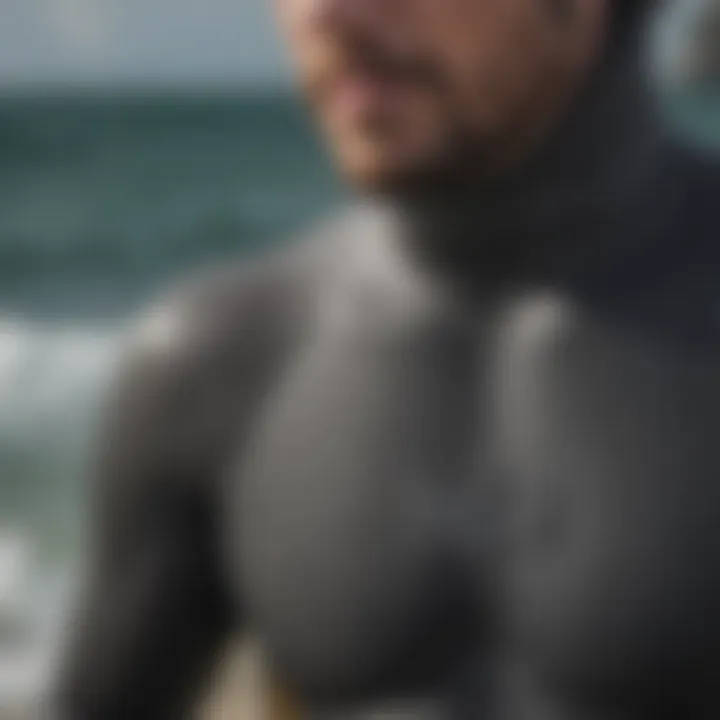
Intro
Choosing the right wetsuit is crucial for any kitesurfing or kiteboarding enthusiast striving to maximize their warmth and performance. As water temperatures fluctuate, the demand for superior thermal insulation grows, leading to innovations in wetsuit design and materials. This article will explore the top wetsuits available on the market today, focusing on the warmest options tailored for extreme athletes. We will delve into vital features such as material technology, design considerations, and user comfort, ensuring that readers can make informed choices in their pursuit of optimal performance.
Equipment Reviews
When evaluating the warmest wetsuits, it is pertinent to consider various aspects, including materials, thermal insulation, and user features. This section aims to provide detailed reviews of leading wetsuit brands and models, along with comparisons that highlight their distinct advantages.
Material Technology
Modern wetsuits utilize advanced materials that enhance thermal insulation. Neoprene remains the most common material, but innovations such as limestone neoprene and Yamamoto rubber offer improved warmth while being environmentally friendly. Limestone neoprene, for instance, has a higher insulation factor than traditional petroleum-based neoprene. Choosing a wetsuit that employs these cutting-edge materials is essential for ensuring warmth during extended water sessions.
Thermal Insulation
Thermal insulation is key for maintaining body heat in cold water conditions. Wetsuits are classified by thickness, often ranging from 2mm to 6mm. A thicker wetsuit, such as a 5/4mm, will provide increased insulation for colder environments. However, flexibility is also necessary to allow for unrestricted movement while kitesurfing. Hence, finding the right balance between thickness and flexibility is crucial.
Design Features
User comfort is often determined by design features of the wetsuit. Look for aspects like seams, zippers, and linings. Flatlock seams can provide comfort but may allow more water in, while fully sealed seams ensure better insulation. Also, entry systems vary—back zippers versus chest zippers—each having pros and cons that can influence the ease of getting in and out.
"Comfort and warmth in a wetsuit should never be an afterthought; they are fundamental for performance."
Top Wetsuit Brands
- O’Neill: Renowned for their high-quality materials and effective heat retention.
- Rip Curl: Offers innovative designs with a focus on flexibility and comfort.
- Billabong: Known for their sustainable practices and advanced thermal technologies.
Travel Destinations
While selecting the proper wetsuit is crucial, knowing where to utilize it amplifies the experience. Various kitesurfing locations around the globe offer unique conditions and amenities, catering to varying levels of expertise.
Popular Spots
Exploring top kitesurfing destinations can be a game-changer for enthusiasts. Destinations such as Cape Town, South Africa, and Hood River, Oregon, are popular for their consistent winds and excellent water conditions.
Off the Beaten Path
For those seeking a quieter, unique experience, consider locations like Lancelin, Australia, or the Lesser Antilles in the Caribbean. These spots provide breathtaking scenery and fewer crowds, perfect for passionate kitesurfers.
Techniques and Tutorials
Gaining proficiency requires a solid understanding of techniques and practice. For beginners, starting with basic skills is essential for building confidence.
Beginner Guides
Learning fundamental maneuvers such as launching and landing can set the groundwork for more advanced skills. Step-by-step tutorials will enhance novice learning.
Advanced Skills
Experienced riders can further refine their abilities, focusing on jumps and tricks. Detailed instructions, along with practical tips, will elevate their riding experience.
Safety Guidelines
Safety in kitesurfing cannot be understated. Understanding the risks associated with varying weather conditions and potential emergencies is vital.
Weather Conditions
Strong winds and changing tides can present dangers. Learn to assess the conditions and adapt accordingly. Awareness of weather patterns ensures a safer experience on the water.
Emergency Protocols
Knowing vital rescue tactics and emergency procedures can save lives. Familiarize yourself with the necessary actions to take in mishaps or accidents.
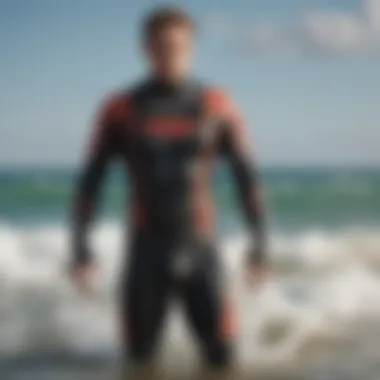
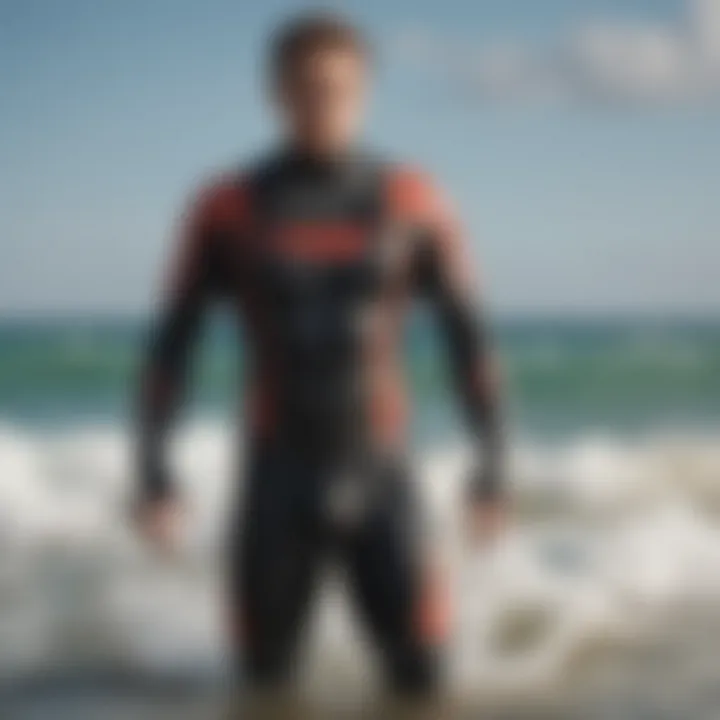
Equipment Maintenance
Regular equipment checks and proper maintenance routines are essential. Inspect gear frequently to ensure it remains in top condition, protecting not only performance but also safety.
Understanding Wetsuits
Wetsuits are essential pieces of gear for various water sports, including kitesurfing and kiteboarding. They serve as a crucial barrier between the body and cold water. This section outlines the purpose and types of wetsuits, providing a foundational understanding necessary for selecting the right one.
The Purpose of Wetsuits
The main purpose of wetsuits is to offer thermal protection while allowing flexibility for movement. They are designed to trap a thin layer of water that warms up due to body heat. This layer provides insulation against cold conditions, making it possible to enjoy water activities in various temperatures. Understanding how a wetsuit functions helps enthusiasts gauge their needs based on typical water conditions and activity duration.
Types of Wetsuits
Wetsuits come in different types, each tailored for specific conditions and performance needs. Selecting the right style is vital for comfort and temperature regulation.
Full Wetsuits
Full wetsuits cover the entire body, providing comprehensive thermal protection. They are typically made from thicker neoprene, ensuring warmth in colder environments. A key characteristic of full wetsuits is their ability to insulate efficiently, making them a preferred choice for extreme conditions. The unique feature of full wetsuits is the option of various thickness levels, allowing customization based on personal sensitivity to cold. However, they may restrict movement compared to shorter options, which is a consideration for those prioritizing agility.
Shortys
Shortys, also known as short wetsuits, cover the torso and have short sleeves and legs. Their main advantage is breathability, which prevents overheating in warmer waters. This makes them a suitable choice for those who engage in activities during hotter seasons. The lightness of the material allows for greater mobility, appealing to kitesurfers who require flexibility. However, they do not provide the same level of insulation as full wetsuits, making them less ideal for colder conditions.
Dry Suits
Dry suits are another alternative, designed to keep the wearer completely dry. Unlike traditional wetsuits, they do not rely on body heat to warm a layer of water. Instead, they use insulation layers to maintain warmth while sealing out water. Their key characteristic is that they are ideal for very cold water situations, making them popular among professional athletes. A unique feature is the ability to wear additional layers, enhancing warmth according to personal needs. The downside is that they can be bulkier and more expensive, a factor that may influence selection for casual users.
Key Factors in Wetsuit Warmth
Understanding the various factors that contribute to wetsuit warmth is essential for kitesurfers and extreme athletes. A wetsuit's effectiveness in retaining heat is determined by multiple elements, including its material technology, fit, and comfort. Each of these characteristics plays a significant role in how a wetsuit performs in cold water conditions, ultimately influencing the wearer's experience in extreme sports.
Material Technology
The material used in a wetsuit greatly affects warmth. Two main aspects to consider are neoprene variations, thickness and insulation, and seam construction.
Neoprene Variations
Neoprene is the primary material used in wetsuits due to its excellent thermal properties. It comes in various types such as standard, limestone, and super-stretch neoprene. The unique feature of limestone neoprene is its minimal environmental impact while still providing superior flexibility and insulation. This makes it a popular choice among brands looking opt for performance and sustainability.
Advantages of high-quality neoprene include:
- Enhanced durability
- Greater elasticity for easy movement
- Effective thermal retention
However, cheaper neoprene options may offer less insulation, affecting user comfort and performance. The key characteristic to remember is that the choice of neoprene can drastically change the overall warmth and flexibility of the wetsuit.
Thickness and Insulation
Thickness is a crucial criterion when determining the warmth of a wetsuit. Generally, thicker suits provide more insulation but can sacrifice flexibility. Common thicknesses range from 2mm to 7mm, each catering to specific water temperatures. For instance, a 3mm wetsuit may be adequate in warmer waters, while a 5mm or thicker wetsuit is necessary for colder environments.
The unique feature of insulation within wetsuits is that it often includes a thermal lining or additional layers that trap heat. High-quality insulation keeps the body warm without excessive bulk. This thickness-to-insulation balance allows kitesurfers to maintain mobility while sustaining body warmth.
Seam Construction
Seam construction also affects a wetsuit's warmth. There are several methods of sealing seams, including flatlock, glued, and blind-stitched seams. Blind-stitched seams are a better option for warmth, as they reduce water entry and maintain heat. The key characteristic of glued seams is that they provide a watertight seal.
While glued seams may add to the cost of a wetsuit, they are beneficial for serious athletes needing dependable warmth in cold conditions. Proper seam construction is essential in maximizing thermal efficiency, allowing athletes to focus on performance.
Fit and Comfort
A well-fitted wetsuit is crucial for optimal warmth and performance. Fit is determined by body mapping, seam placement, and zipper types.
Body Mapping
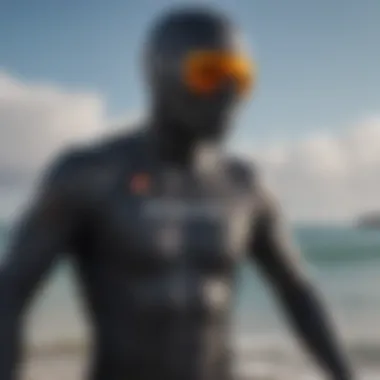
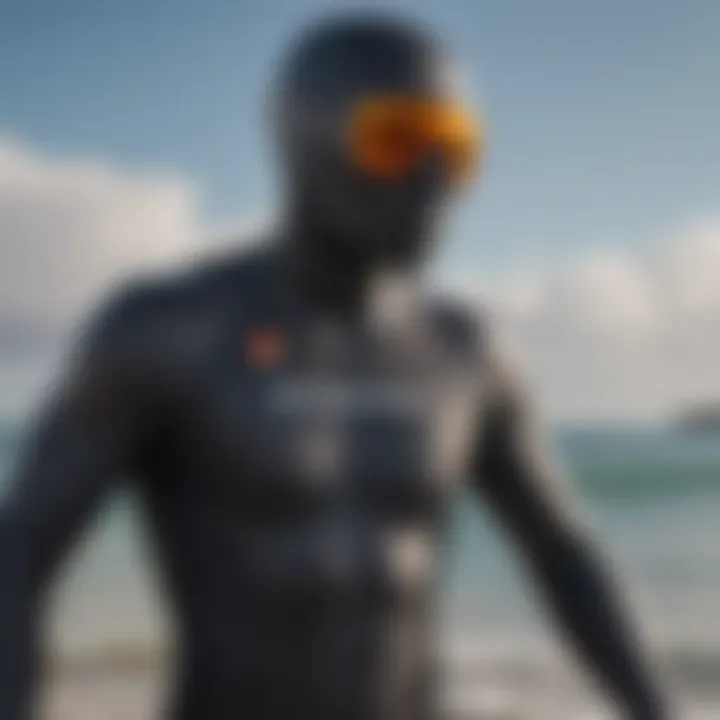
Body mapping involves designing wetsuits to fit specific body shapes and movements. This feature is particularly important for athletes who require unrestricted motion in dynamic activities like kitesurfing. The unique aspect of body mapping is that it considers the different thermal needs of various body parts. For instance, core areas may require more insulation compared to limbs that generate natural heat.
Benefits include:
- Enhanced comfort and mobility
- Improved thermal retention in targeted areas
A downside to poorly fitted wetsuits is the potential for water rushing in, which can lead to loss of warmth and increased discomfort.
Seam Placement
Seam placement also impacts a wetsuit's fit and warmth. Strategic seam positioning can minimize bulk and potential chafing. Flatlock seams, while less watertight, may allow for greater flexibility for less extreme conditions. In contrast, seams that are positioned to follow muscle lines can provide an ergonomic fit, reducing drag.
The key is to find a wetsuit that not only fits well but also places seams in a way that supports freedom of movement during activities.
Zipper Types
Zipper types determine ease of entry and overall comfort. There are primarily three types: back zippers, chest zippers, and those without zippers. Chest zippers usually provide a better watertight seal and more freedom of movement.
The unique feature of a zipper-free option is it eliminates potential water entry points altogether. However, the drawback can be in the difficulty of putting the wetsuit on or taking it off. Ultimately, the selection of the right zipper type can help ensure a well-fitted wetsuit that allows for optimal performance and warmth.
Comparison of Leading Brands
In the pursuit of the warmest wetsuit, the evaluation of leading brands is paramount. This aspect helps in discerning the variety of choices available in the market. Each brand boasts distinct materials, design innovations, and user experiences that can significantly affect warmth and comfort.
The advantages of comparing brands include understanding the nuances of different products and uncovering the best fit based on specific needs. Many kitesurfers and kiteboarders rely on recommendations and insights from users to make informed decisions. Ultimately, brand comparison can illuminate the value proposition of each wetsuit, making the selection process less overwhelming.
Brand A: Overview and Features
Material and Sizing
Brand A offers a strong selection of materials known for thermal efficiency. Their wetsuits commonly utilize high-grade neoprene that provides impressive insulation. The sizing options are extensive, taking into consideration various body types to ensure a snug yet comfortable fit. A key feature of their sizing is the combination of flexible material with tight seams, preventing water from seeping in, thus ensuring warmth. However, the downside can be the limited choices for larger body sizes, which may leave some customers dissatisfied.
User Reviews
Feedback from users of Brand A often highlights its durability and comfort. Many reviews emphasize the excellent design that facilitates ease of movement. However, some users have mentioned that while the suit is warm, it can feel a bit bulky when performing intensive activities. User reviews create a reference point for potential buyers, helping them assess whether the product aligns with their requirements.
Price Range
Brand A typically positions itself in the mid to high price range, reflecting the quality of materials and technology utilized in its products. This price point is often justified by users who feel that the investment pays off in terms of long-lasting performance. However, aspiring buyers may find the price prohibitive, especially those seeking budget-friendly options. Affordable alternatives may present compromises in warmth and performance.
Brand B: Overview and Features
Material and Sizing
Brand B has gained attention for its innovative use of neoprene technology that focuses on providing insulation while minimizing bulk. Their wetsuits are available in a broad range of sizes, accommodating various body shapes. A highly praised aspect of Brand B is its body mapping technology, which allows for targeted warmth in key areas while offering flexibility. Nevertheless, the price may not align with every budget.
User Reviews
The reviews of Brand B's wetsuits generally reflect satisfaction regarding warmth during long sessions in cooler waters. Users appreciate the thoughtful design, but some express concerns about the suit's zippers and ease of entry. User feedback is essential as it signals areas for improvement that brands can address in future iterations.
Price Range
Brand B lies in a competitive price range, making its products accessible to many athletes without compromising quality. This pricing strategy has attracted a loyal customer base that values performance as well as value for money. However, some users feel that cheaper alternatives from other brands may also offer adequate warmth for less intense activities, leading to some price sensitivity.
Brand C: Overview and Features
Material and Sizing
Brand C is celebrated for its eco-friendly materials, which do not sacrifice performance for sustainability. Their wetsuits incorporate varying thicknesses of neoprene that allow for flexibility and warmth. The sizing is also inclusive, ensuring that diverse athletes can find their perfect fit. A unique feature is the use of recycled materials, a boon for environmentally conscious consumers. That said, some users have noted that the eco-friendly aspect may slightly affect the suit's durability.
User Reviews
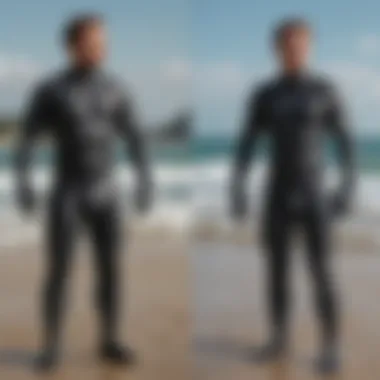
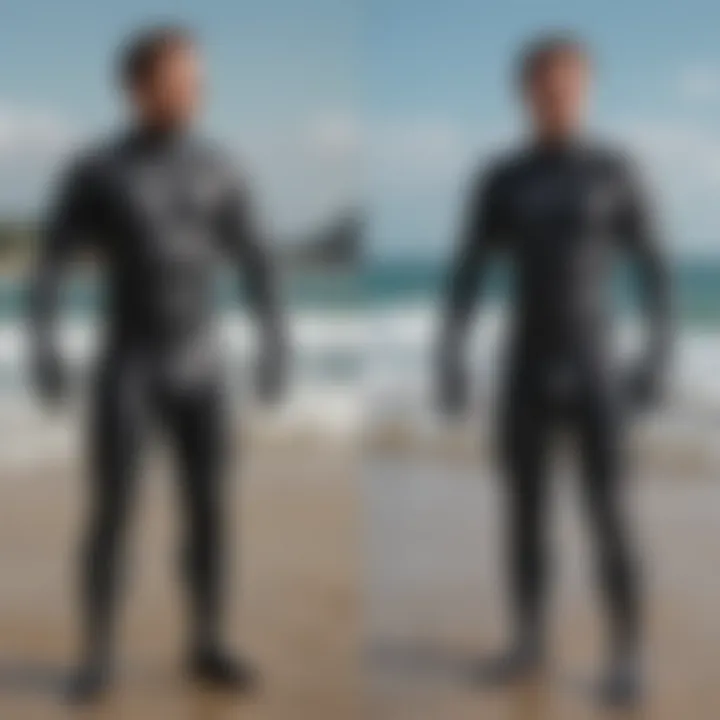
User reviews tend to highlight Brand C’s exceptional comfort and warmth features. Many appreciate the thoughtful construction, which allows convenience without losing performance. However, there can be mixed opinions about the longevity of the eco-friendly materials, which might not stand up to extreme conditions as well as others.
Price Range
Brand C is often on the higher end due to its sustainable approach and innovative materials. While some consumers view the cost as justified for the environmental benefits, others may find it too high, especially if they do not require the specific advantages that Brand C offers. Price is a considerable factor that balances user preferences and values.
User Considerations
Understanding user considerations is crucial when selecting a wetsuit, particularly for kitesurfing and kiteboarding. Each user has different needs based on individual preferences and environmental conditions. Taking these factors into account enhances comfort and ensures optimal performance while in the water. Below are key elements to contemplate in this decision-making process.
Water Temperature and Conditions
Water temperature directly influences the type of wetsuit one should choose. For example, colder waters typically necessitate thicker wetsuits to maintain warmth. Kitesurfers operating in regions like the North Atlantic will likely require a 5 mm full wetsuit, as it provides better thermal efficiency.
Conversely, warmer waters allow the use of thinner suits or even shortys, which offer a combination of flexibility and protection. Additionally, understanding the variability of water conditions, such as currents and wave heights, is essential. Ultraviolet exposure, wind chill, and potential encounters with marine life should also be factored into the decision, guiding users toward the appropriate thickness and style.
Activity Level and Duration
The level of activity and duration spent in the water play a significant role in the wetsuit choice. High-energy activities like kitesurfing demand enhanced mobility. A wetsuit that provides a snug fit but allows proper movement helps reduce fatigue. For vigorous sessions, a thinner wetsuit may suffice, as increased body movement generates heat.
On the other hand, for longer durations, comfort becomes a priority. A drippy suit that retains warmth while not restricting movement can be indispensable for extended periods on the water. In this context, consider the balance between insulation and flexibility; a well-fitting wetsuit can help users enjoy more time in the water without getting cold.
Personal Preferences and Sensitivities
Personal attributes greatly impact the choice of wetsuit. Factors such as body shape, preferences for tightness, and sensitivity to temperature can influence which suit feels best. Some individuals may prefer a looser fit, while others favor a tighter construction for better core warmth.
Sensitivities toward materials are also important. While most wetsuits use neoprene, different variations exist. Some manufacturers offer eco-friendly options or alternative materials, which may suit environmentally conscious users. Understanding individual sensitivities and preferences ensures a more enjoyable experience overall.
"A well-chosen wetsuit can significantly enhance your kitesurfing experience. Knowing your unique preferences and conditions is foundational in this selection process."
Maintenance and Care of Wetsuits
The significance of maintaining and caring for a wetsuit cannot be overstated. A well-cared-for wetsuit not only lasts longer but also performs better. For kitesurfers and extreme athletes, the act of maintaining this essential piece of gear is a crucial element in ensuring both warmth and performance. Proper maintenance helps preserve the suit's flexibility, insulation, and overall appearance. Neglecting this aspect can lead to deterioration and compromise the effectiveness of the wetsuit when it is most needed.
Cleaning Techniques
Cleaning your wetsuit should be done immediately after each use. Saltwater, sand, and other residues can degrade the material over time. Here are some steps to effectively clean your wetsuit:
- Rinse with Fresh Water: Always begin by rinsing your wetsuit thoroughly with fresh water. This removes salt and sand, which can be abrasive.
- Use Mild Soap: When necessary, use a mild soap specifically designed for wetsuits. Avoid regular detergents, as they might damage the neoprene.
- Gently Scrub: Pay attention to areas that are prone to odor, such as the underarms and inside. A gentle scrub using a soft brush can help break down any buildup.
- Rinse Again: After cleaning, rinse the wetsuit again with fresh water to ensure all soap is removed.
- Dry Properly: Hang the wetsuit on a wide hanger and let it air dry in a shaded area. Avoid direct sunlight, as it can harm the neoprene.
These techniques not only keep the wetsuit looking good but also functional for longer periods.
Storage Recommendations
Proper storage is equally crucial for extending the life of a wetsuit. Here are some best practices:
- Avoid Folding: Always hang your wetsuit to prevent creases. Creases can cause stress on the material, leading to potential tears.
- Use Wide Hangers: Choose hangers that are wide enough to support the shoulders. This helps maintain the shape of the wetsuit.
- Keep in a Cool Place: Store the wetsuit in a cool, dry area away from direct sunlight. UV exposure can break down the material and cause fading.
- Flushing Occasionally: Occasionally, flush the wetsuit with fresh water during storage days to keep any lingering salt or residues at bay.
By following these recommendations, you can ensure that your wetsuit remains in optimal condition and continues to provide the warmth and performance needed during water activities.
Good maintenance results in a wetsuit that not only keeps warmth but also supports peak performance in demanding conditions.
Culmination and Recommendations
In any discussion about wetsuits, a thorough conclusion brings together the intricate details that have been explored throughout the article. This final section focuses on the diverse aspects of wetsuit design, materials, and fit, which directly impact warmth and overall performance for water sports enthusiasts. Understanding these elements is vital for anyone interested in elevating their experience, particularly in kitesurfing and kiteboarding, where conditions can change rapidly.
Summary of Findings
- Material Technology: Advanced materials such as varying types of neoprene have been highlighted as critical to the thermal efficiency of wetsuits.
- Fit and Comfort: Body mapping and appropriate seam placement can significantly enhance circulation and minimize discomfort, making the wetsuit warmer in frigid temperatures.
- User Feedback: Reviews from users provide practical insights into how these wetsuits perform under real-world conditions. Positive feedback emphasizes the importance of investing in high-quality materials and thoughtful designs.
- Brand Comparisons: Detailed evaluations of prominent brands reveal distinct qualities, helping buyers understand what to expect from each option available in the market.
The insights from both material analysis and customer experiences underline the necessity for surfers to select a wetsuit that balances warmth with freedom of movement.
Final Thoughts on Selection
When selecting a wetsuit, various factors must be considered to ensure optimal warmth and comfort.
- Water Temperature: Recognizing the specific temperature range of the waters you frequent is essential. Different wetsuits have varying insulation capacities suited for cold, temperate, or warm waters.
- Activity Level and Duration: Choosing a wetsuit that aligns with your activity intensity and how long you spend in the water will enhance your overall experience.
- Personal Sensitivities: Understanding your own comfort requirements plays a pivotal role in selecting the right fit. Factors such as body type and skin sensitivity to materials can influence which wetsuit is the best match.
In summary, the right wetsuit is not merely a choice but a strategic decision that combines knowledge, understanding of personal needs, and an appreciation for the specific conditions of kitesurfing and other water sports. Investing time into evaluating options leads to a selection that prioritizes comfort and warmth, ultimately enriching the experience in the water.







